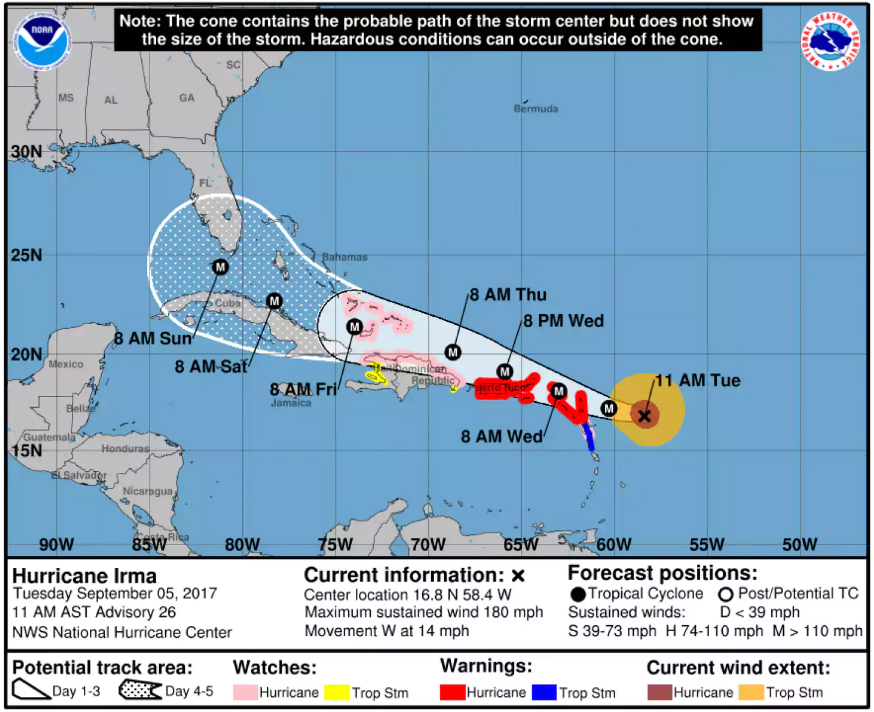For the last few days, I’ve been watching the horrors of Hurricane Harvey and the hardships people in Texas have been going through. Having lived in South Florida for most of my life, I am no stranger to Hurricanes. I lived in Miami just off of Kendall Drive when hurricane Andrew made landfall. Then again I went through Hurricane Wilma and Katrina, not as nasty to us but still both traumatic hurricanes. Hurricanes are not to be taken lightly. Physically it takes years of rebuilding to recover from a direct hit and decades to recover from it mentally. Even if you have insurance it rarely covers everything.
Now I’m finding myself facing a new terror, Hurricane Irma. As I write this, the hurricane is a few days off but looks as if it’s headed right for South Florida. Last night I was watching some TV and the local news channel was running spots announcing that Hurricane Irma is a potential category five Hurricane. The station aired the spots three times. Never once telling anyone anything about the storm. The third time they made an announcement of the Hurricane and proceeded to run four commercials before allowing us to hear the news. They literally shoved the commercials down our throats while holding back on any real information. Finally the weather man, I won’t mention his name, came on with a big smile on his face. Oh I thought, it must mean some good news. Maybe the hurricane has turned away. Maybe it has fallen apart. It turned out to be nothing but gloom and doom. It looks to me like it’s headed right for us. To my dismay it was all delivered to me while he was wearing a great big smile on his face. Why was he smiling the whole time? Have we all become so emotionless and plastic? I’m sorry but things were never this way before. A category five hurricane is certainly nothing to smile about.
It has just been 8 days since hurricane Harvey struck. There are over 27 deaths reported so far and they have still more to recover. Thousands of people are left homeless. So far it looks like the costliest Hurricane on record which will take years for thousands of people to recover from. Hurricane Irma is headed right for us. I’m anxious.
Enough about the weather report, I’m sorry I just had to get that off of my chest. I found a lot of great information of what you need to do to prepare for a hurricane and I’m including it with this article. Take a few minutes and read it over. A category 5 hurricane is very, very serious.
Basic Preparedness Tips
Know where to go. If you are ordered to evacuate, know the local hurricane evacuation route(s) to take and have a plan for where you can stay. Contact your local emergency management agency for more information.
- Put together a go-bag: disaster supply kit, including a flashlight, batteries, cash, first aid supplies, medications, and copies of your critical information if you need to evacuate
- If you are not in an area that is advised to evacuate and you decide to stay in your home, plan for adequate supplies in case you lose power and water for several days and you are not able to leave due to flooding or blocked roads.
- Make a family emergency communication plan.
- Many communities have text or email alerting systems for emergency notifications. To find out what alerts are available in your area, search the Internet with your town, city, or county name and the word “alerts.”
Preparing Your Home
- Hurricane winds can cause trees and branches to fall, so before hurricane season trim or remove damaged trees and limbs to keep you and your property safe.
- Secure loose rain gutters and downspouts and clear any clogged areas or debris to prevent water damage to your property.
- Reduce property damage by retrofitting to secure and reinforce the roof, windows and doors, including the garage doors.
- Purchase a portable generator or install a generator for use during power outages. Remember to keep generators and other alternate power/heat sources outside, at least 20 feet away from windows and doors and protected from moisture; and NEVER try to power the house wiring by plugging a generator into a wall outlet.
- Consider building a FEMA safe room or ICC 500 storm shelter designed for protection from high-winds and in locations above flooding levels.
Hurricane Watch
Hurricane Watch = Conditions possible within the next 48 hours.
Steps to take:
- Review your evacuation route(s) & listen to local officials.
- Review the items in your disaster supply kit; and add items to meet the household needs for children, parents, individuals with disabilities or other access and functional needs or pets.
Hurricane Warning
Hurricane Warning = Conditions are expected within 36 hours
Steps to take:
- Follow evacuation orders from local officials, if given.
- Check-in with family and friends by texting or using social media.
- Follow the hurricane timeline preparedness checklist, depending on when the storm is anticipated to hit and the impact that is projected for your location.
What to do when a Hurricane is six hours from arriving..
-
- If you’re not in an area that is recommended for evacuation, plan to stay at home or where you are and let friends and family know where you are.
- Close storm shutters, and stay away from windows. Flying glass from broken windows could injure you.
- Turn your refrigerator or freezer to the coldest setting and open only when necessary. If you lose power, food will last longer. Keep a thermometer in the refrigerator to be able to check the food temperature when the power is restored.
- Turn on your TV/radio, or check your city/county website every 30 minutes in order to get the latest weather updates and emergency instructions.
- Turn on your TV/radio, or check your city/county website every 30 minutes in order to get the latest weather updates and emergency instructions.
What to do when a Hurricane is 6-18 hours from arriving.
- Turn on your TV/radio, or check your city/county website every 30 minutes in order to get the latest weather updates and emergency instructions.
- Charge your cell phone now so you will have a full battery in case you lose power.
What to do when a Hurricane is 18-36 hours from arriving.
- Bookmark your city or county website for quick access to storm updates and emergency instructions.
- Bring loose, lightweight objects inside that could become projectiles in high winds (e.g., patio furniture, garbage cans); anchor objects that would be unsafe to bring inside (e.g., propane tanks); and trim or remove trees close enough to fall on the building.
- Cover all of your home’s windows. Permanent storm shutters offer the best protection for windows. A second option is to board up windows with 5/8” exterior grade or marine plywood, cut to fit and ready to install.
What to do when a hurricane is 36 hours from arriving
- Turn on your TV or radio in order to get the latest weather updates and emergency instructions.
- Build or restock your emergency preparedness kit. Include food and water sufficient for at least three days, medications, a flashlight, batteries, cash, and first aid supplies.
- Plan how to communicate with family members if you lose power. For example, you can call, text, email or use social media. Remember that during disasters, sending text messages is usually reliable and faster than making phone calls because phone lines are often overloaded.
- Review your evacuation plan with your family. You may have to leave quickly so plan ahead.
- Keep your car in good working condition, and keep the gas tank full; stock your vehicle with emergency supplies and a change of clothes.
After the Hurricane
- Listen to local officials for updates and instructions.
- Check-in with family and friends by texting or using social media.
- Return home only when authorities indicate it is safe.
- Watch out for debris and downed power lines.
- Avoid walking or driving through flood waters. Just 6 inches of moving water can knock you down, and one foot of fast-moving water can sweep your vehicle away.
- Avoid flood water as it may be electrically charged from underground or downed power lines and may hide dangerous debris or places where the ground is washed away.
- Photograph the damage to your property in order to assist in filing an insurance claim.
- Do what you can to prevent further damage to your property, (e.g., putting a tarp on a damaged roof), as insurance may not cover additional damage that occurs after the storm
When their is no hurricane: Make a hurricane plan
- Know your hurricane risk. Talk to your local emergency management agency.
- Make an emergency plan.
- Build or restock your basic disaster supplies kit, including food and water, a flashlight, batteries, chargers, cash, and first aid supplies.
- Consider buying flood insurance.
- Familiarize yourself with local emergency plans. Know where to go and how to get there should you need to get to higher ground or to evacuate.
- Stay tuned to local wireless emergency alerts, TV, or radio for weather updates, emergency instructions, or evacuation orders.
More Important Information
- 2017 Hurricane Preparedness Week Social Media Toolkit(link)
- National Hurricane Center (link)
- National Weather Service Hurricane Safety (link)
- When the Waves Swell – Hurricane Animated (Video)
- How to Prepare for a Hurricane (PDF)
- Hurricane Playbook (PDF)
- Prepare Your Organization for a Hurricane Playbook(PDF)
- Communication Tools (PDF)
- Hurricane Creative Materials (PDF)


